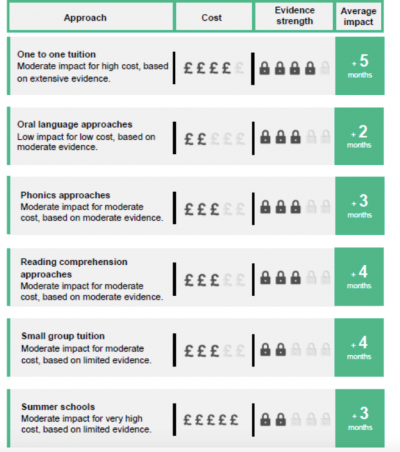Interventions
The publication Read On. Get On (2016) authored by Jonathan Douglas on behalf of the National Literacy Trust and Save the Children has the subtitle ‘A strategy to get England’s children reading’ is a really useful read about reading in the UK. It opens with this message, “Every year in England, thousands of children leave primary school without the confidence and fluency in reading that they need. The impact on their learning, life chances and engagement with reading is significant. We need to ensure that every child can read well by the age of 11. Specific groups are far more likely to fail. For some children this will be related to additional needs, but for many children the reason is less clear. The reading gap between boys and girls in England is one of the widest in the developed world. Children from poorer backgrounds are also more likely to fall behind. Every child should have the support they need to prevent this from happening” (p.iv).
It makes the following points for action in relation to Reading in the Primary Years:
- priorities for improving children’s reading consolidate and build on major improvements in phonics teaching
- stronger formative assessment of children’s reading
- access to the latest evidence-based pedagogical approaches for teachers, teaching assistants and school governors
- exploration of why a child might be struggling with reading in order to match the need with an appropriate approach or intervention
- a model for how a “self-improving schools system” would work
- sustained strategy to dramatically increase reading for pleasure especially for children who are not already excited by reading
- stronger support for primary leadership (ibid, pp.18-20)
See the full document.
In Ireland, Mary Nugent (chair) Lucy Gannon Yvonne Mullan Diarmuid O’Rourke in a revised edition (2019) Effective Interventions for Struggling Readers (Second edition, 2019). A Good Practice Guide for Teachers. National Educational Psychology Service.
See the earlier pack ‘Effective Interventions for Struggling Readers Resource Pack’ (2012).
What teachers would like to see: 10 strategies to achieve world-class literacy
1. Consistently good teaching
2. An English specialist for every primary school
3. Early intervention to support struggling readers
4. Tailoring reading strategies to fit the individual child
5. Encouraging parents to read to their children
6. Early childhood support to introduce children to books, stories and nursery rhymes
7. Encouraging children to read for pleasure
8. Starting the formal teaching of reading later
9. Making creative use of technology
10. Trusting teachers
(Source: Reading Wise , 2014).
Examples of interventions
There are many interventions in Primary schools aimed at improving children’s reading. Here are a selection:
- The Power of Reading. The training programme supports schools to raise engagement and attainment in reading and writing for all children. CLPE
- Every Child a Reader was designed to tackle illiteracy in primary schools CaR offered a layered, three-wave approach to supporting children with reading in key stage 1. The majority of money allocated to the project will be spent on Reading Recovery, an intense, one-on-one remedial programme for six-year-olds. The 2011 evaluation is available at here.
- MacBeath & Alexandrou (2015) An independent study of Computer-Based Literacy Programme for Accelerated Reading Acquisition.
- Reading Wise (2018) Explored closing the reading attainment gap by increasing the effectiveness of teaching assistants.
- BookTrust is the UK’s largest reading charity. It offers a number of programmes and interventions to support children and families to experience the joy of reading and its associated benefits.
- ThirdSpaceLearning offer a number of curriculum interventions including literacy.
- Reciprocal Reading is a programme created by a team from Fischer Family Trust Education Literacy (FFT Literacy) and designed to improve reading skills in older primary pupils. It is a structured approach to teaching strategies – questioning, clarifying, summarising and predicting – that students can use to improve their reading comprehension.
- Catch Up Literacy© is a one to one intervention for learners who are struggling to learn to read. It is delivered by Teaching Assistants and consists of two 15-minute sessions per week. See the EEF evaluation here.
- Nuffield Early Language Intervention designed to improve listening, narrative and vocabulary skills. Three to five weekly sessions are delivered to small groups of children with relatively poor spoken language skills. It is a 30-week programme starts in the final term of nursery and continues in Reception year.
- Accelerated Reader (AR). Is widely used in England, but much of the evidence for the approach comes from the USA. It is a web-based programme that encourages children to read for pleasure See the EEF evaluation at read for pleasure.
One intervention is not enough
It is clear that tackling the literacy challenge with a single intervention is unlikely to be enough. In 2014, the EEF reviewed more than 1,200 studies related to older, struggling readers. The most successful approaches boosted outcomes by between four and five months. See the summary table below:

References
Douglas, D. (2016) Read on. Get on. A strategy to get England’s children reading. London: National Literacy Trust/Save the Children.
Nugent, M., Gannon, L. Mullan, Y. & O’Rourke, D. (2019) Effective Interventions for Struggling Readers (Second edition, 2019). A Good Practice Guide for Teachers. National Educational Psychology Service
Reading Wise (2014) Phonics plus: what’s missing from the government’s literacy strategy.
An excellent resource that includes critical reviews of reading interventions is by Keith Topping. The book ‘Children’s Reading and Instruction’ (2019).

